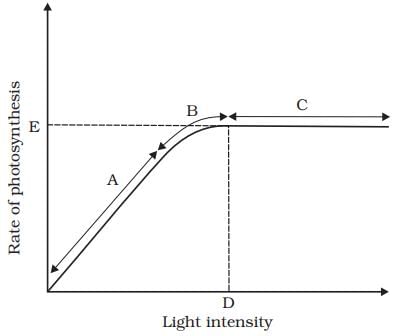Factors Affecting Photosynthesis - ACT MCQ
10 Questions MCQ Test - Factors Affecting Photosynthesis

Given a graph with light intensity on the x-axis and photosynthesis rate on the y-axis, at what point does the rate of photosynthesis stop increasing with increased light intensity due to other limiting factors?

Given a graph with light intensity on the x-axis and photosynthesis rate on the y-axis, at what point does the rate of photosynthesis stop increasing with increased light intensity due to other limiting factors?
What is the primary limiting factor for photosynthesis?
At what atmospheric concentration of CO2 do C4 plants show saturation in photosynthesis?
Which of the statements given above is/are correct?
i. The dark reactions of photosynthesis are temperature controlled and are more sensitive to temperature changes compared to light reactions.
ii. C4 plants have a higher rate of photosynthesis at elevated temperatures than C3 plants.
iii. Tropical plants generally have a lower temperature optimum for photosynthesis than plants adapted to temperate climates.
iv. Water stress affects photosynthesis primarily by reducing the availability of CO2 due to stomatal closure.
Which of the statements given above is/are correct?
i. Water plays a direct role in the photosynthetic process by participating in the light reactions.
ii. Water stress can lead to wilting of leaves, affecting the surface area for photosynthesis.
iii. C3 plants have a higher temperature optimum for photosynthesis compared to C4 plants.
iv. The effect of temperature on photosynthesis varies depending on the plant's habitat.
Assertion: Light saturation occurs at 10 percent of full sunlight, which does not commonly limit the rate of photosynthesis in natural settings.
Reason: At higher light intensities, other factors become limiting.
why do greenhouse crops like tomatoes and bell peppers show higher yields when grown in a CO2-enriched atmosphere?
What is the effect of increasing carbon dioxide concentration beyond 0.05 percent on plants over long periods?
Assertion: In high light intensities, the rate of photosynthesis in both C3 and C4 plants increases.
Reason: C4 plants show a higher rate of photosynthesis at lower temperatures compared to C3 plants.














